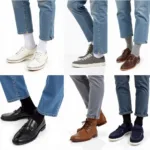Mood rings, those fascinating pieces of jewelry that claim to reflect our emotions, have been captivating our imaginations for decades. But have you ever stopped to wonder what the mood ring colors mean?
While they might not predict the future or unlock the secrets of the universe, mood rings offer a fun and colorful way to think about our feelings. These rings change color based on our body temperature, which can fluctuate slightly depending on our emotional state.
Deciphering the Language of Mood Ring Colors
Understanding the meaning behind mood ring colors can be a bit like learning a new language. Each shade is associated with a specific emotion or state of mind. While interpretations may vary slightly, here’s a general guide to the most common mood ring color meanings:
Cool Colors: Serenity and Tranquility
- Blue: Feeling calm, relaxed, and at peace. Think of a clear blue sky or a tranquil ocean.
- Green: Contentment, happiness, and a sense of balance. Imagine lush green forests and rolling hills.
- Purple: Romance, mystery, and a touch of magic. Picture a starry night sky or a field of lavender.
Warm Colors: Passion and Energy
- Yellow: Optimism, creativity, and a burst of energy. Think of the sun shining brightly.
- Orange: Excitement, enthusiasm, and a zest for life. Picture a vibrant sunset or a crackling fire.
- Red: Passion, love, and intense emotions. Imagine a beating heart or a blooming rose.
Neutral Colors: Balance and Transition
- Brown: Grounded, practical, and connected to nature. Think of the earth beneath your feet.
- Gray: Neutral, contemplative, and in a state of reflection. Picture a cloudy day or a calm sea.
- Black: Mysterious, powerful, and sometimes indicating stress or anxiety. Imagine a dark and stormy night.
The Science Behind the Color Change
While mood rings can’t literally read our minds, the technology behind their color-changing abilities is quite interesting. These rings contain liquid crystals that are sensitive to temperature fluctuations. As our body temperature changes, so does the structure of these crystals, resulting in a shift in color.
For instance, when we’re feeling calm and relaxed, our blood flow tends to be more consistent, keeping our extremities at a relatively stable temperature. This results in cooler colors like blue or green. However, when we experience strong emotions like excitement, anger, or stress, our blood flow can increase to our core and away from our extremities, causing a slight drop in finger temperature. This shift in temperature is reflected in warmer colors like red or black on the mood ring.
Mood Rings: Fun Fashion or Insightful Tool?
It’s important to remember that mood rings are primarily a novelty item and should not be taken as a precise measure of our emotions. Our feelings are complex and influenced by a multitude of factors beyond just our body temperature.
what does colors on a mood ring mean
However, mood rings can still be a fun and engaging way to spark conversations about emotions and self-awareness. They can also serve as a visual reminder to pay attention to our feelings and how our bodies respond to different situations.
Mood Ring Colors: A Colorful Conversation Starter
Whether you wear a mood ring for its whimsical charm or as a lighthearted conversation starter, understanding the general meanings behind the colors can add another layer of enjoyment to this unique piece of jewelry. So next time you see someone sporting a mood ring, don’t be afraid to ask them, “What color are you feeling today?”. You might just spark a fascinating conversation about emotions, energy, and the intriguing world of mood ring colors.

